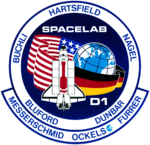STS-61-A
| Mission emblem | |||
|---|---|---|---|

|
|||
| Mission dates | |||
| Mission: | STS-61-A | ||
| COSPAR-ID : | 1985-104A | ||
| Crew: | 8th | ||
| Begin: | October 30, 1985, 5:00 p.m. UTC | ||
| Starting place: | Kennedy Space Center , LC-39A | ||
| Landing: | November 6, 1985, 17:44:51 UTC | ||
| Landing place: | Edwards Air Force Base , Runway 17 | ||
| Flight duration: | 7d 0h 44m 51s | ||
| Earth orbits: | 112 | ||
| Track height: | 383 km | ||
| Orbit inclination : | 57.0 ° | ||
| Covered track: | 4.6 million km | ||
| Payload: | Spacelab , GLOMR | ||
| Team photo | |||
 v. l. No. Front: Reinhard Furrer, Bonnie Dunbar, James Buchli, Henry Hartsfield; Back: Steven Nagel, Guion Bluford, Ernst Messerschmid, Wubbo Ockels |
|||
| ◄ Before / After ► | |||
|
|||
STS-61-A ( english S pace T ransportation S ystem ) is a mission designation for the US Space Shuttle Challenger ( OV -99) of NASA . The launch took place on October 30, 1985. It was the 22nd space shuttle mission and the ninth and last successful flight of the space shuttle Challenger.
team
Main team
- Henry Hartsfield (3rd space flight), commander
- Steven Nagel (2nd space flight), pilot
- James Buchli (2nd spaceflight), mission specialist
- Guion Bluford (2nd space flight), mission specialist
- Bonnie Dunbar (1st spaceflight), mission specialist
-
Reinhard Furrer (1st space flight), Payload Specialist ( DFVLR ) Germany

-
Ernst Messerschmid (1st space flight), Payload Specialist (DFVLR) Germany

-
Wubbo Ockels (1st space flight), Payload Specialist ( ESA ) Netherlands

This was the first and so far only time that a spaceship with eight people on board took off. (An eight-person landing was also carried out with the STS-71 ten years later .) This was also the first space shuttle flight in which the pilot had already had space experience.
replacement
A replacement has been nominated for Furrer and Messerschmid:
-
Ulf Merbold (DFVLR) Germany

Mission overview
During this space flight, the European Spacelab was carried in the hold. The three European payload specialists carried out mission D1 (Germany 1) of ESA . For the first time, part of a manned mission was monitored from outside the USA or the Soviet Union: while the flight of the space shuttle was being controlled from the NASA control center in Houston , the DLR, with its center in Oberpfaffenhofen , Bavaria , was responsible for the scientific experiments in the space laboratory . A total of 75 different experiments were carried out.
The landing took place on schedule at Edwards AFB in California . The orbiter was transported back to Florida five days later by special aircraft.
At the beginning of the flight, a small communications satellite housed in the Challenger's hold was deployed: GLOMR (Global Low Orbiting Message Relay) was built for the US military ( DARPA ) and was a demonstration model for remote interrogation of military sensors. The satellite, which had a diameter of 60 centimeters and weighed 52 kilograms, entered the denser layers of the earth's atmosphere on December 26, 1986 after 14 months and burned up.
Amateur radio DPØSL
The amateur radio station on board Spacelab had the German extraterritorial callsign DPØSL during the D1 mission. The Shuttle Amateur Radio Experiment ( SAREX ) was carried out on board the Columbia, giving students and radio amateurs the opportunity to communicate directly with the astronauts. During the mission there was, among other things, amateur radio contact with the German Antarctic research station Georg-von-Neumayer .
See also
- List of space shuttle missions
- List of manned space flights
- List of spacemen
- German spacemen
- Manned space travel
Web links
- NASA Mission overview (English)
- Video summary with comments of the crew (English)
- STS-61-A in the Encyclopedia Astronautica (English)
Individual evidence
- ↑ Biography of Ulf Merbold. ESA, accessed September 10, 2014 .
- ^ Andreas Schöwe: Mission Space Shuttle . Ed .: Bechtermünz Verlag. 1999, ISBN 3-8289-5357-3 , pp. 121 .
- ↑ ZS6HS: DP0SL German Spacelab Mission. Retrieved March 10, 2016 .
